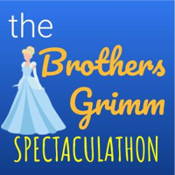
Explore this Show
Overview
Synopsis
You may think you know the story of Cinderella, Rapunzel, or Hansel and Gretel, but you’ve never seen them quite like this. Guided by the aptly-named Narrator One and Narrator Two, The Brothers Grimm Spectaculathon is a madcap ride through all 209 of the Brothers Grimm fairy tales. An ensemble cast zips from story to story, weaving each one together as we discover the origin stories of some of literature’s most well-known characters. You’ll meet some lesser-known figures too-like Plinkie Plie, Girl Without Hands, and the crab people. Just for good measure, there’s also a talking fish, an evil raven, and an audience member who’s a little too invested. The Brothers Grimm Spectaculathon is an ideal option for high school theatres looking for a crowd-pleaser with minimal set/tech requirements, flexible casting, and roles for strong comedic actors. A one-act version is also available, and the newest edition of the script was updated in 2021 to include a subtle pandemic reference.
Show Information
Context
Plot
Characters
| Name | Part Size | Gender | Vocal Part |
|---|---|---|---|
|
Lead |
Either Gender |
Non-singer |
|
|
Lead |
Either Gender |
Non-singer |
|
|
Featured |
Either Gender |
Non-singer |
|
|
Featured |
Either Gender |
Non-singer |
|
|
Featured |
Male |
Non-singer |
|
|
Featured |
Male |
Non-singer |
|
|
Featured |
Male |
Non-singer |
|
|
Featured |
Female |
Non-singer |
|
|
Featured |
Either Gender |
Non-singer |
|
|
Featured |
Male |
Non-singer |
|
|
Featured |
Female |
Non-singer |
|
|
Featured |
Either Gender |
Non-singer |
|
|
Featured |
Either Gender |
Non-singer |
|
|
Featured |
Male |
Non-singer |
|
|
Featured |
Male |
|
|
|
Featured |
Either Gender |
|
|
|
Featured |
Female |
|
|
|
Featured |
Female |
|
|
|
Featured |
Male |
|
|
|
Featured |
Either Gender |
|
|
|
Featured |
Male |
|
|
|
Ensemble |
Female |
Non-singer |
|
|
Ensemble |
Male |
Non-singer |
|
|
Ensemble |
Female |
Non-singer |
|
|
Ensemble |
Female |
Non-singer |
|
|
Ensemble |
Either Gender |
Non-singer |
|
|
Ensemble |
Male |
Non-singer |
|
|
Ensemble |
Female |
Non-singer |
|
|
Ensemble |
Female |
Non-singer |
|
|
Ensemble |
Female |
Non-singer |
|
|
Ensemble |
Male |
|
|
|
Ensemble |
Female |
|
|
|
Ensemble |
Either Gender |
|
|
|
Ensemble |
Female |
|
|
|
Ensemble |
Female |
|
|
|
Ensemble |
Either Gender |
|
Songs
A song with an asterisk (*) before the title indicates a dance number; a character listed in a song with an asterisk (*) by the character's name indicates that the character exclusively serves as a dancer in this song, which is sung by other characters.
Monologues
Scenes
Key Terms
Sorry! We do not currently have terms for this guide.
Videos
Quizzes
Themes, Symbols & Motifs
Sorry! We do not currently have learning modules for this guide.
Quote Analysis
Sorry! We do not currently have learning modules for this guide.
